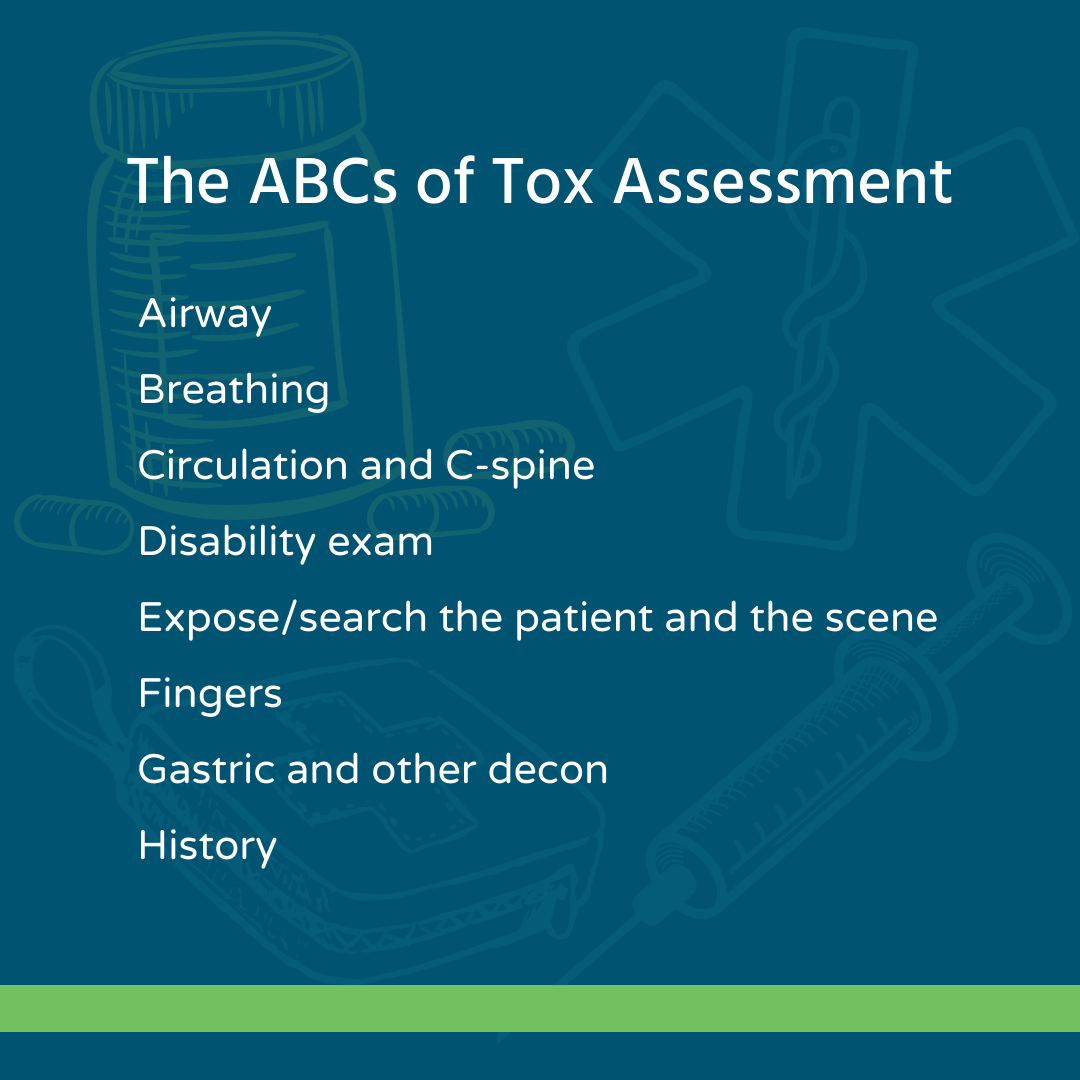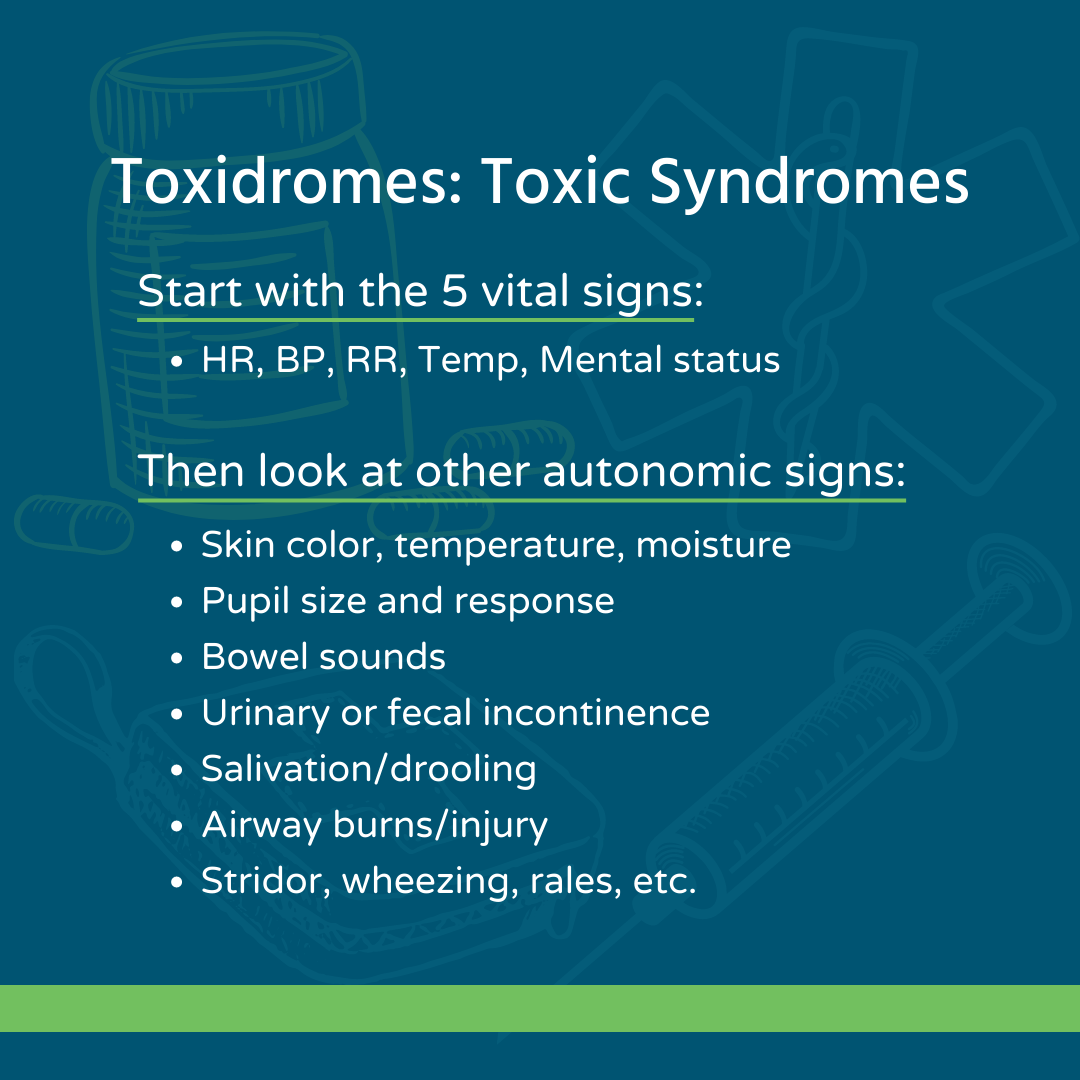
Dan Limmer, BS, NRP

by Limmer Education
Our articles are read by an automated voice. We offer the option to listen to our articles as soon as they are published to enhance accessibility. Issues? Please let us know using the contact form.
Toxicology and toxidromes seem like a foreign language to many in EMS. The sheer number of possible toxins a patient may encounter make management of the poisoning or overdose patient seem like a needle in a haystack proposition. Let's take this complex topic and make it a little more approachable.
Put on PPE as appropriate and assess:
Airway
Breathing
Circulation and C-spine: sometimes tox patients also have trauma
Disability exam: AVPU, glucose/thiamine, naloxone
Expose/search the patient and the scene
Fingers: check for abdominal tenderness, enlarged bladder
Gastric and other decon
History: Tox cases are history cases

Family
Friends
Physicians
Pharmacies
You may need this information to keep yourself or your patient safe and anticipate problems or hazards that may arise during transport. This may be especially true for chemicals that yield toxic products when mixed – familiarity with the individual ingredients may not be enough.
Possible sources of information:
Internet Pill identifiers
Your regional poison center: 1-800-222-1222
Hazmat resources
Be aware that all “-cides” like rodenticides, herbicides, fungicidal, bacteriocidal and virucidal agents will have a unique “EPA Reg. No.” on the packaging that identifies the exact formulation and concentration of the product.
Knowing/reporting the agent by a brand name is insufficient because the brand name may apply to dozens or even hundreds of products with widely varying ingredients and purposes.
To identify a toxidrome start with the 5 vital signs: HR, BP, RR, Temp and “MENTAL STATUS” -- the rest of the body functions to support the CNS.
Then, look at other autonomic signs:
Skin color, temperature and moisture
Pupil size and response
Bowel sounds (often N, V or D in the prehospital setting)
Urinary or fecal incontinence
Salivation/drooling
Airway burns/injury
Stridor and other adventitious breath sounds (wheezes, rales…)

Some very common basic toxidromes include:
opioid toxidrome, not to be confused with other depressant drug or alcohol intoxication
sympathomimetic/withdrawal toxidrome
cholinergic toxidrome (wet)
anticholinergic toxidrome (dry)
Toxidromes may be present in whole or in part. Some important and common poisons do not have a striking toxidrome early in the course of poisoning (APAP, salicylates) when they are most treatable.
If you are a paramedic, learn Advanced Hazmat Life Support.
Many toxicology patients are saved by good supportive care.
Airway support and oxygen
Fluids, pressors, etc.
Few antidotes are available – but if there is one it’s important to know about it because timely administration may be lifesaving. (Ex.: hydroxocobalamin for cyanide from smoke inhalation.)
Looking for fluff-free, conversational CE? The 7 Things EMS podcast gives you exactly that, covering a variety of topics that truly make you a better provider. Each episode delivers 7 Things you need to know about that topic. Pick and choose which topics interest you. There’s no boring content, no complex paperwork, and no membership. Listen to the toxicology episode, or see all episodes.
Each podcast episode streams directly from LC-Ready and qualifies for one hour of F3 CE (CAPCE approved).
Just purchase the episode(s) you want, listen to the 45-minute audio, and take a short test. As long as your LC-Ready profile is filled out with your State and/or NREMT number, your CE credit will appear in your account. It couldn't be easier!
Anthony J. Tomassoni, M.D., M.S, FACEP, FACMT practices and teaches Emergency Medicine and Toxicology at Yale University. Dr. Tomassoni received a B.A. degree in Science Education and a M.S. in Human Biochemistry. His interest in medicine and toxicology was born from a foundation of analytical and clinical chemistry. Prior to entering medicine he taught basic sciences and computer applications to gifted students and to educators. He received his MD degree from UMDNJ – New Jersey Medical School and completed a residency in Emergency Medicine and a fellowship in Medical Toxicology at the University of Cincinnati (UC). While at UC he served as an EMS medical director and as a flight physician for 5 years. In his previous position Dr. Tomassoni contributed to the growth and certification of the collaborative Northern New England Poison Center which he served as Medical Director; while at the Maine CDC he was the architect of three Regional Resource Centers for Public Health Emergency Preparedness created to span preparedness gaps between public health, healthcare organizations, and other response organizations in Maine.

Dan Limmer, BS, NRP

Limmer Education